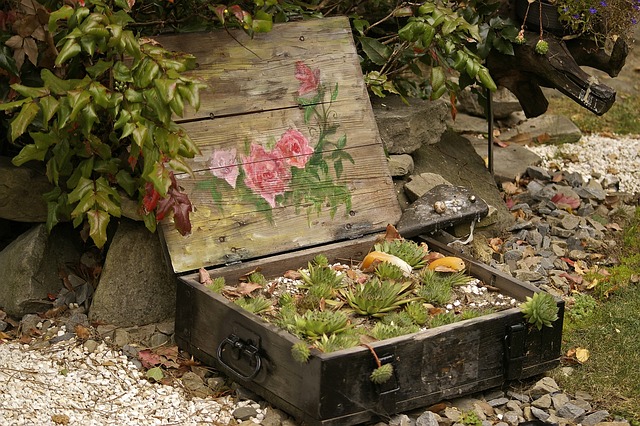“Transforming your garden can significantly boost your mental well-being,” says Dr. Emily Lambert, conservation biologist and Seedball co-founder. “Spending time outdoors, whether in a garden or green area, has numerous benefits for mental and physical health. Sunlight promotes vitamin D production, essential for overall health, while fresh air clears the mind, energizes the body, and uplifts the mood.”
‘The sensory experience of being outside has also been shown to improve our mental health,’ Emily adds. ‘Nature’s sights, sounds, and fragrances all offer relaxing and soothing effects, helping to lessen life’s worries and concerns while encouraging awareness and connection to something bigger than oneself.’

So, we know that spending time in our garden and practicing mindful gardening is beneficial to our health, but how can we improve it even further? We spoke with garden designers and wellness experts to uncover the simple ideas that would transform our plot into the perfect wellness garden.
Grow a Green Wall in Your Garden
A patio with pots, a trellis fence with climbing plants
Creating a ‘green wall’ in your yard may include teaching a climber to ascend over a fence, erecting a rose-covered trellis, or simply hanging pots on a brick wall using a planter like Nkuku’s Jara Terracotta planter. Any of these approaches can help you build a vertical garden with green ferns and trailing plants.
Whatever your green wall looks like, it will not only hide an unsightly border or maximize vertical space in a tiny garden; it will also inspire emotions of peace and well-being.
‘Many research have been conducted to investigate the science of why being outside makes you feel so wonderful. It’s been shown that merely staring at greens decreases stress and improves healing,’ adds Camilla Phelps, a gardener and horticulturalist who works for the gardening for health charity Thrive.
“A green wall on even the tiniest of plots can add a wellness level to your outdoor area, whether it’s simply draped with climbers or a complex mosaic of vertical plants. It also provides a feeling of security and protection, as well as its own microclimate.Build resilience using a tree.
An olive tree in the garden.
Choosing the right tree for your garden helps increase its sustainability and resistance to climate change. Fast-growing privacy trees may also hide inquisitive eyes from neighbors.
However, landscape designer and RHS Chelsea Flower Show award-winning garden designer Robert Myers believes that a tree’s power and beauty may serve as a living metaphor for our own perseverance in difficult times.
‘We emphasize the importance of trees as resilient and crucial components of the garden’s landscape. They play a vital role in minimizing difficulties like heat and generating a more sustainable environment, according to Robert.
‘Trees in the garden also promote recuperation, inspiration, and a shared appreciation for nature’s tenacity and beauty.’
Relax your senses.
A dark water element at the RHS Chelsea Flower Show.
(Image credits: Heather Young/Future Publishing Ltd.)
We tend to concentrate on how our garden appears, but paying attention to how it smells, sounds, feels, and even tastes may help us create a feelgood garden setting that improves our overall well-being.
You may add a modest water feature, fill pots or borders with aromatic plants, cultivate herbs and veggies for smell and flavor, or plant grasses for movement and pleasant rustling noises.
“Incorporating different textures and sounds into your space can help turn your garden into both a visual and sensory experience,” says Diana Yates, author of Growing at Greenfields, a book about her magnificent Scottish garden, and creator of The Reclaimed Garden Company.
‘The sounds of rushing water, a gravel walk under your feet, wind chimes, or tall grasses blown by the breeze may all help to calm the mind and ease nervous sensations.’
Include flowers for nostalgia.
Pink climbing rose plant.

Nostalgiacore is a décor trend that has been linked to reduced anxiety, but it isn’t only for the home. Plants that evoke happy memories and sensations of comfort and ease are essential in a wellness garden. These might be any flowers that have positive connotations for you, but the rose is the most likely to evoke reminiscence.
“Roses are one of the most definitive elements in the quintessential English country garden, whether they’re delicately climbing up walls, vigorously rambling over fences, standing pretty in containers, or filling out ornamental flower beds,” says Ian Limmer, head of the nursery and plant breeding program at Peter Beales Roses.
‘The color and variety are up to personal preference, but to get the most out of the smell, move them forward into places where you’ll be sitting or strolling often. In general, the most fragrant roses are old-fashioned and historic roses, which may be planted along paths to assist excite the senses as you stroll through a garden, trained over pergolas, or around shaded seats for a magnificent sitting bower.
Do not be frightened of getting your hands filthy.
A plant containing a courgette
When it comes to growing a wellness garden, we shouldn’t be afraid to get our hands dirty – literally.
Aside from the mindfulness advantages of feeling dirt trickle through our fingers or seeing worms and other creepy crawlies go about their business in the ground, there is a scientific reason to get mired in the mud.
‘If you’re fortunate enough to be able to get your hands in the soil, you could discover that planting just makes you happy – friendly bacteria in soil have been found to strengthen your immune system and increase the feel-good hormone serotonin,’ explains Camilla Phelp.
Move to enhance endorphins.
View of nasturtiums, salvia in flower bed, and no-dig raised bed with well-rotted manure in October garden in Carmarthenshire, Wales
Have you heard of the runner’s high? You may receive the same feel-good effect by just being active in your garden.
‘Moving around outside generates endorphins, which provide happy sensations and keep you active. “Being outside provides a break from the stresses of daily life and allows us to take a moment to ourselves and appreciate the world around us,” says Seedball’s Dr. Emily Lambert.
Thrive, the gardening for health nonprofit, promotes gardening’s physical exercise as a ‘gateway to mental health and wellness’. According to studies, 45 minutes of gardening burns the same number of calories as 30 minutes of cardiovascular exercise.
Create a wildflower garden with box hedges and trails to express your inner wild side.

Wildflowers are nature’s tough cookies, with tenacious, durable blossoms that can grow in the harshest of environments. They also link us to the surroundings of our houses, extending our perspectives. They also assist birds, pollinators, and other species flourish, providing long-term health advantages.
The greatest thing is that you don’t have to be a professional gardener to implement this wellness garden concept. All you need are some wildflower seeds, such as these from SeedBall on Amazon, or you could consider investing in meadow turf, which is also available on Amazon.
‘The brilliant colors and various forms and sizes of wildflowers make a visually stunning scene; this may help boost our emotions and encourage respect for nature,’ says Dr Emily Lambert.
‘Surrounding oneself with wildflowers promotes a connection to the natural world, which has been shown to alleviate stress and anxiety and enhance mental health. Observing the wildlife that comes and benefits from the wildflower nectar may also help us feel peaceful, attentive, and relaxed as we stay in the present moment.
‘But ultimately, knowing you’re contributing to biodiversity, helping pollinators and animals flourish, and creating a beautiful sea of flowers may give you a feeling of purpose and appreciation for your surroundings, all of which improves mental health!’Taste the wonderful life.
A vegetable patch at RHS Chelsea 2023.
Growing your own food is another conscious and gratifying activity, so try building a raised vegetable bed or planting a few visually appealing edibles to reap the feel-good feelings.
‘Herbs and berries are easy options to begin with, but knowing you’ve cultivated them and put in the effort can enhance their flavor,’ explains Dr Emily Latimer.
You can also cultivate edible flowers. Clover, mallow, daisy, and even dandelions may make interesting complements to salads, sandwiches, and other tasty dishes.
Primrose offers a great selection of grow-your-own packages, including cocktail garnishes, pizza toppings, and spices to get you started.
Create a mindfulness garden with a pink greenhouse, deck chairs, plants, pots, and gravel.
There is a time and place for intense, calorie-burning activity in the garden, but other jobs may be slowed down and completed mindfully.
‘Sowing seeds, trimming, and planting have an inherent attentiveness. It’s about focusing on the work at hand and letting go of day-to-day concerns,’ adds Camilla Phelps.
Try it when spreading seeds.
‘Mix sand and compost with your own hands, and feel the texture transform into the ideal seed-sowing medium for seedlings to build strong roots,’ she explains.
‘Fill pots to the rim, gently tapping them down, and observe the size and form of the seeds as you distribute them on top of the soil or press them softly into the compost.
‘Pour water in slowly, then watch and wait. Nasturtiums, sunflowers, peas, and beans all germinate quickly. Watching them develop is magical, and it taps into a core, childish curiosity that is so vital in unlocking those moments of pure bliss.
Finally, our gardens are more than just decorative areas; they may improve our well-being in a variety of ways.
“In a world where the pace is often frenetic, the garden serves as a refuge,” explains Robert Myers. ‘It serves as a reminder of nature’s curative power, motivating everyone who visit to find solitude, renewal, and delight in the beauty of the natural world.
